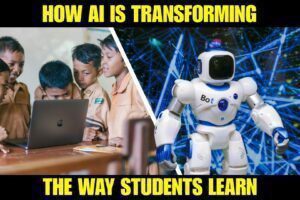The integration of artificial intelligence (AI) into language learning has created new paths for education, making it more efficient, personalized, and interesting. This essay investigates How AI Is Transforming the Way Students Learn Languages Online, offering deep insights for beginners and advanced learners alike.
Disclaimer
The content in this article, “How AI Is Transforming the Way Students Learn Languages Online,” is meant for informational purposes only. While we try for accuracy, the rapid improvements in AI technology and instructional approaches mean that certain knowledge may become outdated. Readers should use this content as a broad reference and check with language learning professionals or educators for individualized help.
Medical and Educational Advice: This essay does not constitute formal educational or professional advice. Always seek help from experienced educators or language learning professionals regarding specific language acquisition methods or learning tactics.
Data Privacy: The usage of AI systems in language learning sometimes requires personal information for optimization and personalization. Users must understand the privacy policies of the platforms they use, ensuring that their data is treated securely and properly.
Limitations of AI: AI technology may not account for every individual’s unique learning style or pace. While they offer tailored experiences, learners may still require human interaction to fully grasp complicated linguistic nuances and cultural settings.
Technological Dependence: Over-reliance on AI technologies may lead to a shallow comprehension of the language. Learners must balance technology use with conventional learning methods and interactions with native speakers.
By engaging with this article, you accept and agree to the disclaimers offered. For particular questions or specialized learning strategies, please connect with educational professionals.
Introduction to AI in Language Learning
Artificial intelligence is altering several areas, including education. Within language learning, AI aids the process by giving tools that promote faster and more effective acquisition. The benefits range from tailored learning experiences to quick feedback, all of which respond to the different needs of language learners.
The Importance of Language Learning
In our increasingly globalized society, language abilities are more vital than ever. Proficiency in many languages not only offers up job prospects but also develops cross-cultural conversation and understanding. Traditional language learning methods, while successful, often lack the adaptability and interactivity that modern learners need. AI technology fills this gap, giving novel solutions that suit to individual learning preferences.
How AI Is Transforming the Way Students Learn Languages Online
The Role of AI in Language Learning
Personalized Learning Environments
AI’s capability to personalize educational experiences depending on individual development is one of its most significant advantages. Unlike conventional language courses that follow a predefined curriculum, AI systems assess user data to generate individualized learning pathways.
Adaptive Learning Algorithms
Adaptive learning algorithms measure a student’s strengths and weaknesses through continual engagement. For instance, if a student excels in vocabulary but has problems with pronunciation, the AI can adapt the curriculum to focus more on oral activities. This level of customization guarantees that learners spend their time efficiently, concentrating on areas that require improvement.
Instant Feedback Mechanisms
Immediate feedback is vital for mastering a new language. AI-driven platforms give real-time corrections and suggestions, allowing learners to make adjustments as they practice.
Examples of Feedback Systems
Tools like Grammarly and Google Translate provide quick feedback on grammar, spelling, and style. In language learning, platforms such as Busuu apply AI to assess spoken or written exercises and offer corrective suggestions, guaranteeing that students may enhance their skills rapidly.
Natural Language Processing (NLP)
Natural Language Processing plays a critical role in enabling machines to understand and interact with human language. This technology permits learners to practice interactions with AI chatbots, giving them a secure setting to hone their speaking skills.
Conversational Practice with AI
AI chatbots imitate realistic interactions, allowing learners to engage in communication without the pressure of human judgment. For example, programs like HelloTalk connect learners with native speakers for language exchange, while also delivering AI-driven help to facilitate communication.
Gamification of Learning
Gamification introduces game-like aspects into educational environments to boost engagement and motivation. AI can help design gamified language learning experiences that make studying enjoyable.
Motivational Game Mechanics
Many language learning apps employ points, levels, and awards to incentivize learners. For example, Duolingo has a streak system, where learners gain points for daily practice. This gamification increases consistent engagement and converts the learning process into a fun task.
Advantages of AI in Language Learning
1. Enhanced Engagement and Motivation
AI-driven platforms often feature interactive and gamified components that keep students engaged. The utilization of dynamic content, tailored challenges, and rapid rewards produces a good learning climate.
2. Accessibility for Diverse Learners
With AI, language learning becomes more accessible to a global audience. Online platforms allow students from all backgrounds to access great educational resources at their convenience, reducing geographical obstacles.
3. Cost-Effective Solutions
Many AI-powered language learning solutions are available for a fraction of the cost of traditional courses. Free or low-cost programs enable learners to access high-quality instructional materials without the financial burden normally associated with formal language sessions.
4. Continuous Improvement through Data Analysis
AI systems learn from user interactions, always updating their algorithms to optimize the learning experience. As more learners engage with these platforms, the technology becomes increasingly successful at offering individualized recommendations.
5. Comprehensive Resource Availability
AI systems generally combine a range of resources, including videos, quizzes, and interactive exercises, offering learners a variety of tools to deepen their study.
Disadvantages of AI in Language Learning
1. Lack of Human Interaction
One of the major limitations of AI in language learning is the limited potential for human connection. Conversing with native speakers or experienced instructors is crucial for improving fluency and cultural awareness.
2. Risk of Over-Reliance on Technology
Dependence on AI technologies may lead to superficial learning. While these technologies can provide rapid answers, they may not stimulate critical thinking or a deep grasp of linguistic intricacies.
3. Data Privacy Concerns
The usage of AI typically requires collecting personal data to enhance user experiences. Learners must be informed of data privacy policies and the risks linked with sharing personal information.
4. Quality Variation Among AI Tools
Not all AI language learning tools are made equal. The usefulness and reliability of these platforms might vary greatly, leading to diverse experiences among learners.
5. Cultural Nuances and Context
AI may fail to explain the cultural nuances inherent in language. Without human context, pupils could miss out on critical details that determine language use in different cultures.
Expert Opinions on AI in Language Learning
Dr. Lisa Patel, Linguistics Expert
Dr. Patel underlines the transformative potential of AI in language education: “AI technology provides an unprecedented possibility to personalize the learning experience. By assessing individual learning patterns, AI can customize content to meet various needs, ensuring that each learner receives the support necessary to succeed.”
Professor John Smith, AI and Education Researcher
Professor Smith underlines the necessity of integrating AI with traditional methods: “While AI is a wonderful tool, it should not replace human instructors. The emotional and contextual aspects of language learning are best conveyed through human interaction. A mixed approach, integrating AI with traditional education, may yield the best outcomes.”
Maria Gonzalez, Language Learning Coach
Maria Gonzalez supports ethical AI use: “As we embrace AI in language learning, it’s vital to maintain a balance. Students should be encouraged to engage with native speakers and immerse themselves in real-world language experiences. AI should complement, not substitute, these great opportunities.”
Additional Information
Effective Strategies for Utilizing AI in Language Learning
- Set Clear Objectives: Define precise goals for your language learning journey. Whether you desire to gain conversational fluency or understand technical jargon, clear objectives guide your study efforts.
- Use AI in Combination with Traditional Methods: Leverage AI technologies alongside regular language lessons or chat groups. This integrated method provides for a deeper and more thorough language learning experience.
- Practice with Native Speakers: Utilize AI chatbots for practice, but actively seek opportunities to talk with native speakers. Language exchange systems like Tandem connect learners with persons from around the world for meaningful conversations.
- Stay Consistent: Consistency is key in language learning. Dedicate a particular amount of time each day to practice, whether it’s using AI tools, watching films in the target language, or engaging in reading exercises.
- Explore Multiple Resources: Don’t limit yourself to a single AI platform. Different tools offer unique features and learning approaches. Exploring a variety of resources helps provide a more well-rounded language education.
Best Practices for Data Privacy in AI-Language Learning
- Read Privacy Policies: Before using any AI language learning software, educate yourself with its data privacy policy to understand how your data will be used and safeguarded.
- Limit Personal Information Sharing: Be cautious with the personal information you provide with AI systems. Provide only the necessary info to minimize potential privacy issues.
- Use Safe Connections: Always access language learning platforms using safe and trusted networks to protect your personal information from illegal access.
FAQs
1. How can AI increase my language learning efficiency?
AI boosts efficiency by personalizing learning experiences, delivering rapid feedback, and changing content based on your success, allowing you to focus on areas needing development.
2. What are some popular AI language learning tools?
Popular tools include Duolingo, Babbel, Busuu, and Rosetta Stone, each offering distinct features such as adaptive learning and gamified activities.
3. Is it safe to utilize AI language learning apps?
Most credible AI language learning apps prioritize user privacy and data protection. However, it’s crucial to study their privacy policies and terms of service before use.
4. Can AI assist me attain fluency in a language?
AI may considerably enhance your language learning journey by delivering targeted lessons and practice chances, but reaching fluency frequently requires additional engagement with native speakers and immersion experiences.
**5. How do I
choosing the best AI language learning tool for me?** Consider your learning goals, preferences, and budget. Research multiple platforms read user reviews, and possibly attempt free trials to evaluate which product matches best with your goals.
Conclusion
AI is altering the landscape of language learning, making it more accessible, individualized, and interesting for students globally. By embracing the power of AI, learners can benefit from individualized experiences, quick feedback, and immersive conversational practice. However, it is vital to maintain a balance between technology and human interaction to acquire a thorough comprehension of language. As technology continues to improve, the future of language learning promises even more inventive solutions, paving the path for a global community of proficient language speakers. Embracing these shifts can lead to enriching educational experiences that promote lifetime language skills and cultural understanding.




